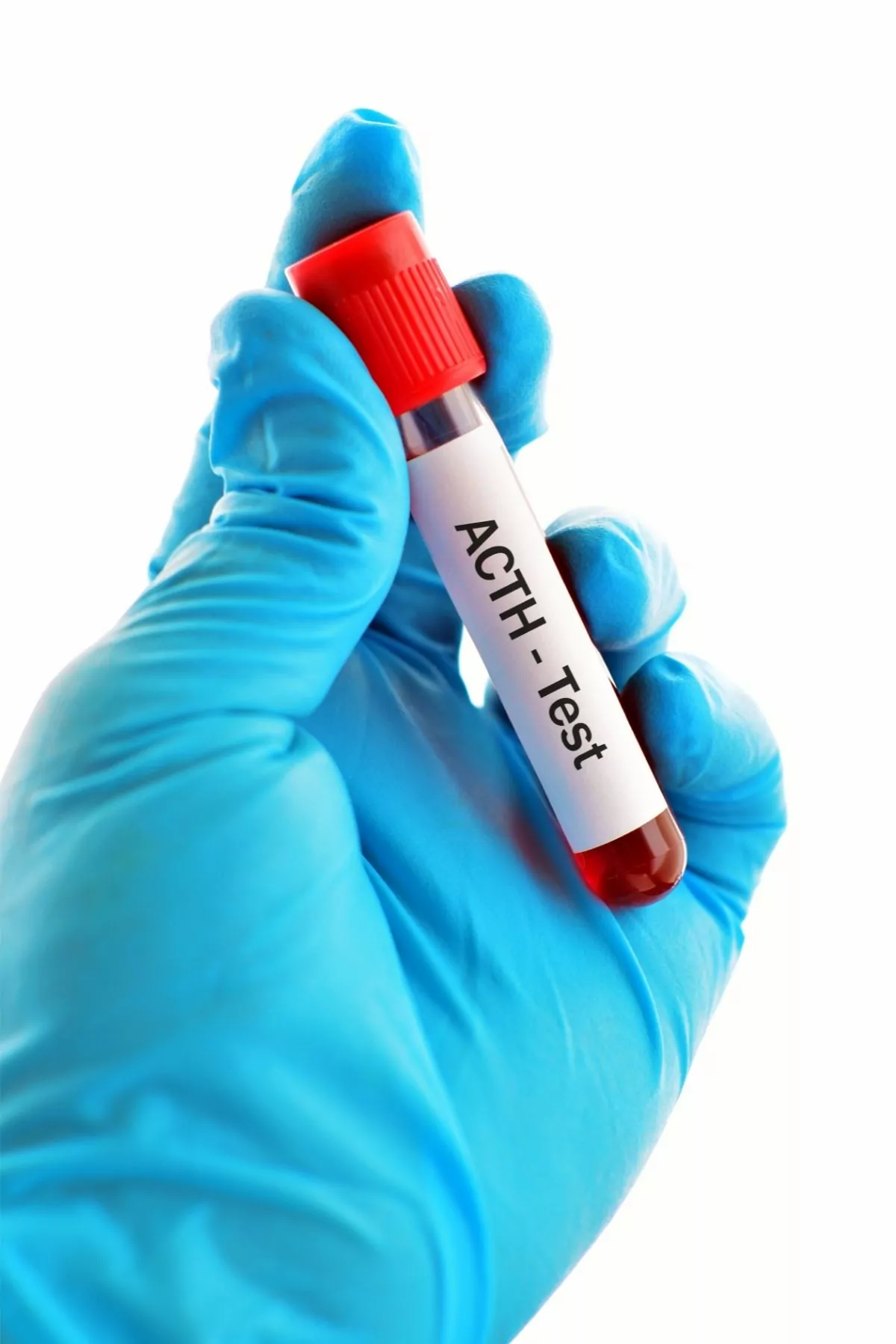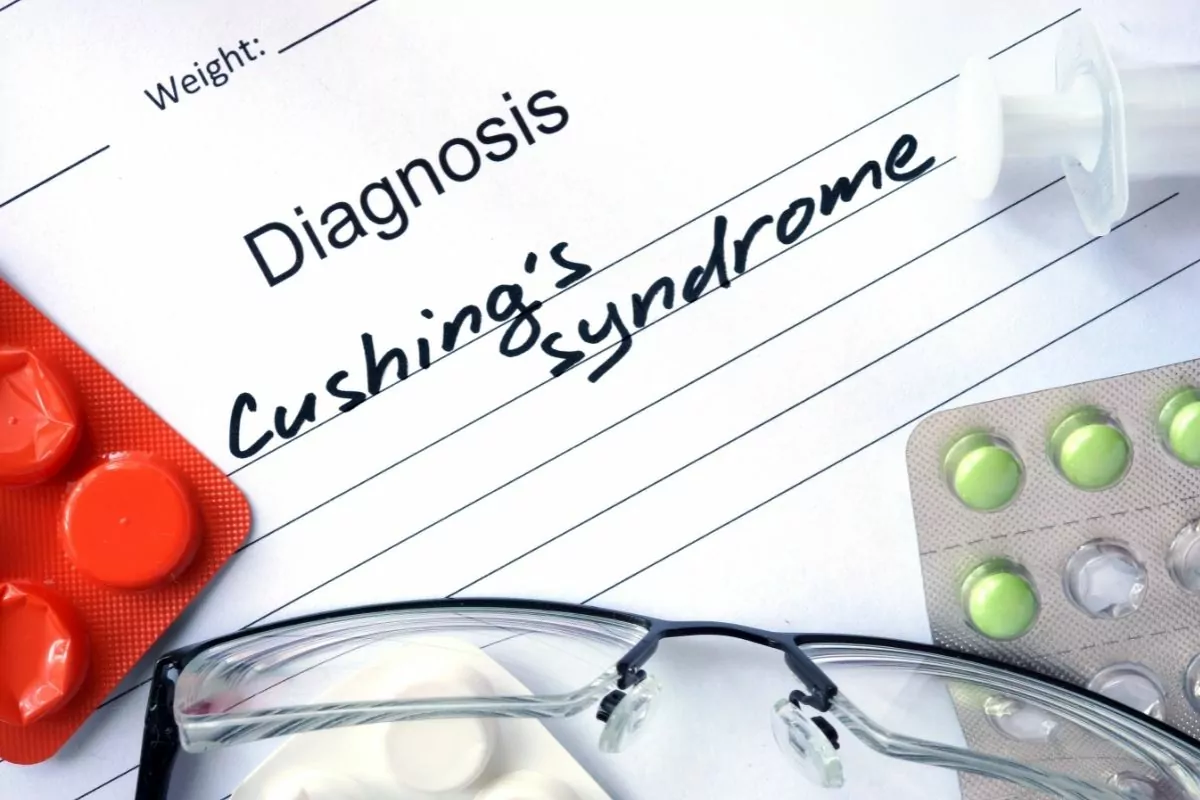What is an ACTH Stimulations Test for Dogs?
You may have heard it mentioned, and you may know that doctors have used it for humans for a long time, but did you know there’s also the ACTH stimulation test dog version? The ACTH stimulation test is also called a Cushing’s disease test for dogs and is essential for almost any veterinary practice.
Cushing’s disease occurs when a dog’s cortisol levels increase. The increase in cortisol can happen for many reasons, and it is essential to determine the cause to help your dog as fast as possible.
The cause of increased cortisol levels in dogs is Cushing’s disease, but there are other options. Especially in these more complicated cases, the ACTH stimulation test for dogs comes into play and is an essential diagnostic tool!

The ACTH Stimulation Test For Dogs – Side Effects
The side effects of doing an ACTH stim test for dogs are infrequent. However, a few dogs may experience one of the following symptoms:
- Nausea and possibly vomiting.
- Swollen and red injection site.
- Itchy skin.
- Elevated body temperature.
However, the side effects should not persist for more than a few hours after administering the synthetic hormone.
What is Hyperadrenocorticism in Dogs?
Hyperadrenocorticism in dogs is the clinical term for Cushing’s disease and happens when the adrenal glands within the body stop responding to the usual negative feedback mechanism that regulates cortisol. The lack of a normal feedback response can lead to excessive production and release of the hormone, causing increased cortisol levels in dogs.
There are several causes of canine hyperadrenocorticism; Sometimes, the disease occurs due to a tumor in one of the adrenal glands. The adrenal gland cannot respond appropriately to the signals telling it to stop – it just continues elevating the cortisol levels.
It is a tumor within the pituitary gland – a gland within the brain. The tumor then means that the pituitary gland tells the adrenal to produce excessive cortisol.
Lastly, Cushing’s disease can also occur due to prolonged steroids.
No matter what is causing the increase in cortisol levels, even mild Cushing’s disease can be severe for your dog. Constantly increasing stress hormone levels can affect the whole body and put it at serious risk of developing conditions and illnesses, everything from kidney damage to diabetes.
Patients suffering from Cushing’s disease will have one of the following symptoms. Often they will have even more.
- Increased appetite.
- Thinning of the skin and hair.
- Increased drinking and urination.
- Weakened muscles.
- Lethargy (tiredness).
- Enlarged abdomen with a round appearance.
If you worry that your dog may be suffering from some of the symptoms mentioned above, it is essential to contact your veterinary care provider. These will be able to complete a Cushing’s disease test to rule out if that might be what is affecting your dog – and help it get back on track as soon as possible!
What Does the ACTH Stimulation Test for Dogs Cost?
How much an ACTH stimulation test costs will vary a lot from one veterinarian to another. Depending on your location, you should generally expect the test alone to cost between $200 and $300.
However, the ACTH stim test is far from the only cost to consider when your dog is being diagnosed with Cushing’s disease – or perhaps it is just being checked for it as part of diagnosing another endocrine ailment.
A good veterinarian will always keep your unique economic situation in mind when planning a diagnosis, but some things are necessary to reach a definite diagnosis.
Before making a diagnosis, your vet will first need to complete a full physical examination. Further paraclinical tests will often follow the physical exam before reaching a Cushing’s disease test for dogs. These tests can include bloodwork, urinalysis, and possibly an ultrasound to look for tumors within the body.
All in all, the steps from suspecting the condition to reaching a diagnosis can be a lot and can be expensive. Make sure you always confer with your vet throughout the progress if you have any financial questions.

What is the ACTH Stim Test for Dogs Protocol?
Let us rewind a little for it all to make a little more sense, as some of it can seem complicated.
Within the brain is the pituitary gland. The gland sends a signal with a natural hormone, the adrenocorticotropic hormone (ACTH). The signal then reaches the adrenal gland and tells the adrenal gland to produce and release another hormone: Cortisol. Finally, the cortisol gets released into the blood.
On average, in healthy animals, the increase in cortisol levels in the blood will, after some time, cause a new signal to be sent back to the pituitary gland within the brain – telling the gland to stop releasing ACTH. As a result, the pituitary gland stops producing ACTH, which means the adrenal gland to produce cortisol – a feedback loop.
This feedback loop is disturbed when an animal suffers from hyperadrenocorticism or hypoadrenocorticism (Addison’s disease).
With an ACTH stimulation test for dogs, the veterinarian aims to mimic the natural feedback loop by injecting the dog with a synthetically produced ACTH. Injecting this synthetic hormone will mimic the natural pathways and thereby demonstrate the capacity of the adrenal glands to produce cortisol in response to the ACTH.
Most veterinarians recommend that your dog hasn’t eaten for eight hours before the test to ensure the correct baselines. However, this may NOT be the case if your dog is already on some medications, so be sure to confer with your veterinarian before fasting your dog.
The ACTH stimulation test begins with your veterinarian drawing a small quantity of blood. The vet will then measure cortisol levels in this blood as the baseline, or “starting” levels.
After drawing this sample, a small quantity of ACTH gets injected into the dog’s bloodstream. Your veterinarian will ask you and your dog to stay in the clinic or hospital for a couple of hours to avoid any excitement or stress that may occur due to a car ride or similar. Increased excitement can falsely increase cortisol levels.
A few hours later, often one to two hours, a repeat blood sample is drawn. Your veterinarian will also measure the cortisol levels in this blood sample to determine if the body’s response to the ACTH is appropriate.
Usually, your dog will then be able to go home after completing the test. Hereafter the blood samples are sent to a laboratory for evaluation, and the laboratory will then return the results to your veterinarian. How long it takes depends on your location and your veterinarian, but usually, it takes a couple of days.
When the adrenal glands aren’t functioning correctly, it can cause Cushing’s disease (canine hyperadrenocorticism), where the glands produce too much cortisol. But, it can also be the opposite, which is Addison’s disease (hypoadrenocorticism). Both are complicated endocrine conditions, and confirming a diagnosis is challenging.
But, after an ACTH stim test, you and your dog are hopefully now one step closer to a diagnosis – or at least the next step!
Risks Associated With ACTH Stimulation Tests in Canines
As we’ve already talked about, there are very few side effects or risks associated with an ACTH stimulation test.
It is always crucial to inform your veterinarian of any medications, supplements, herbal remedies, or similar your dog may be receiving. Some drugs may affect either your dog’s condition or the ACTH stimulation test, so make sure to inform your vet if anything has changed since they last saw your furry friend.
How Will I Know if my Dog Has Cushing’s Disease After the Test?
There are two types of Cushing’s disease in dogs. So after the ACTH stimulation test, what we see will depend on the type of Cushing’s.
With Cushing’s that stems from an issue with the pituitary gland, we expect to see significantly increased cortisol levels shortly after the injection with the synthetic ACTH hormone.
The adrenal gland is already over-stimulated due to natural ACTH being secreted continuously from the pituitary gland. Adding more synthetic ACTH, therefore, cause a marked increase, and the adrenal glands are highly responsive.
If Cushing’s disease stems from an issue with the adrenal gland, there may be an exaggerated cortisol level after the injection. But, the synthetic ACTH may also only slightly elevate it.
As both types of Cushing’s can have increased cortisol levels after an ACTH stimulation test, it confirms whether your dog has Cushing’s. However, it does not say which type. To determine that, we need other tests.
What Is The Low-Dose Dexamethasone Suppression Test?
To determine what type of Cushing’s disease a dog is suffering from, your veterinarian may suggest that they perform a low-dose dexamethasone suppression test.
A negative feedback loop exists between ACTH from the pituitary gland and cortisol from the adrenal glands in a healthy dog. The negative feedback loop allows the body to rapidly change the blood cortisol levels.
In this test, synthetic cortisol, dexamethasone, is injected into the bloodstream. To mimic what occurs in the negative feedback loop. In healthy dogs, this would cause a suppression of the ACTH.
In dogs with Cushing’s disease, the negative feedback loop is either completely gone or diminished, as cortisol is high all the time.
If the Cushing’s is of pituitary origin, the synthetic dexamethasone injection diminishes the negative feedback loop. We will see this as a slight decrease in cortisol in the blood sample compared to a sample taken before the dexamethasone injection.
If Cushing’s disease is due to a change within the adrenal gland, the negative feedback loop is already lost. In this case, the ACTH has little or no effect on cortisol secretion from the adrenal glands. Therefore, injecting dexamethasone will not activate the negative feedback loop, and we will see no reduction in cortisol levels in the blood samples taken.
In most cases, a combination of tests is necessary to confirm the diagnosis of Cushing’s disease. However, occasionally other paraclinical tests may also be required. These tests can include x-rays or ultrasounds or event MRI or CT scans to demonstrate the presence of tumors within the pituitary gland or adrenal glands.
Luckily, Cushing’s is most often reasonably easy to diagnose based on clinical symptoms and the ACTH stimulation test, and you and your vet can get started on a treatment plan.
Most veterinarians will treat both types of Cushing’s disease with medication. The only cure available is to remove the tumor, which is only possible if the Cushing’s is related to the adrenal glands. However, removing a tumor from the adrenal glands is a surgery that can be both risky and very complex.
Therefore, medicinal therapy is often the therapy of choice for both pituitary and adrenal-related Cushing’s disease in dogs.
Currently, the only FDA-approved drug is trilostane. The drug works by inhibiting the production of cortisol within the adrenal glands, thereby lowering the concentration that gets released into the blood and limiting the untoward effects it can have. To help your dog to feel much better sooner rather than later.

Conclusion
We all want our furry friends to be happy and healthy, and we especially don’t wish to see them suffer from any chronic illnesses. However, you should contact a veterinarian if you suspect your dog may be suffering from Cushing’s disease – or are just displaying some of the symptoms.
Early diagnosis and starting treatment early is by far the best way to give your four-legged friend the best chances.
